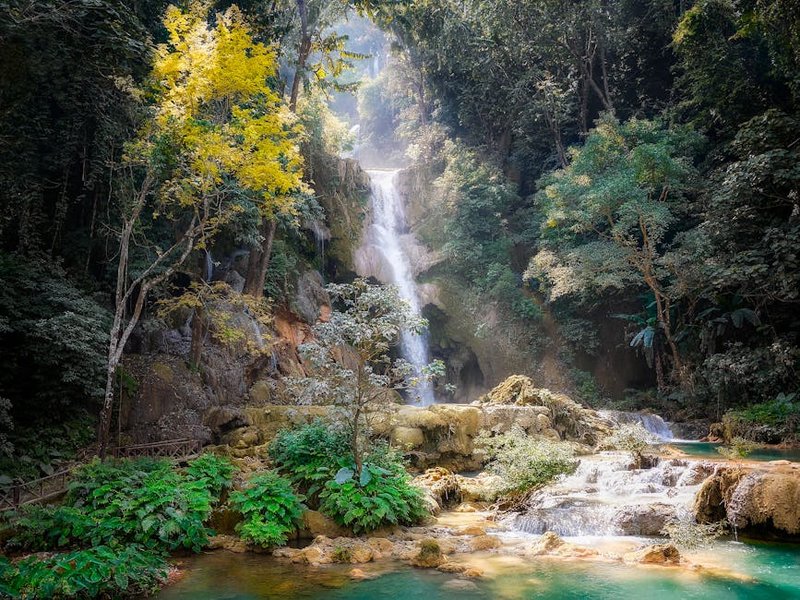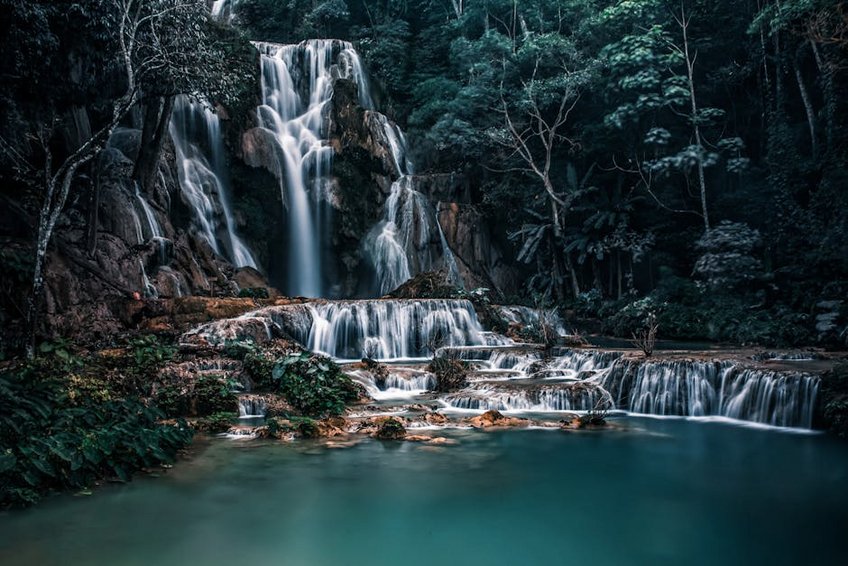Laos Kuang Si Waterfalls: Turquoise Pools and Jungle Adventures
Laos Kuang Si Waterfalls present one of Southeast Asia’s most breathtaking natural wonders with their multi-tiered turquoise pools cascading through lush jungle landscapes just outside Luang Prabang. These stunning waterfalls feature crystal-clear mineral-rich waters perfect for swimming, accessible walking trails through protected bear sanctuary areas, and photographic opportunities at every elevation level. This comprehensive guide covers everything from optimal visiting seasons and budget planning to cultural etiquette and hidden spots beyond the main cascades.
Essential Information About Kuang Si Waterfalls
Kuang Si Falls spans three main tiers with the highest cascade plunging approximately 60 meters (197 feet) into vibrant turquoise pools created by limestone mineral deposits. Located roughly 29 kilometers (18 miles) southwest of Luang Prabang in northern Laos, this natural attraction operates within a protected conservation area that includes an Asiatic black bear rescue center. The entire complex covers multiple hectares of dense jungle terrain with well-maintained wooden walkways and staircases connecting the different waterfall levels.
Local legends suggest the waterfalls originated when a wise man dug into the mountainside to create a water source for nearby villages, though geologically they formed through centuries of water erosion through limestone rock formations. The Kuang Si Bear Rescue Center, established in 2003, provides sanctuary for bears rescued from illegal wildlife trade while educating visitors about conservation efforts. Entrance fees directly support both bear protection initiatives and maintenance of the walking trails and facilities throughout the park.
Location and Accessibility Details
Understanding the logistics helps maximize your visit experience from start to finish.
- Kuang Si Waterfalls sit 29 kilometers southwest of Luang Prabang city center, requiring approximately 45-60 minutes travel time via tuk-tuk, private car, or organized minivan tour depending on road conditions.
- The bear sanctuary and lower waterfall pools feature wheelchair-accessible paths, though upper tiers involve steep staircases with handrails that may challenge visitors with mobility issues during rainy season.
- Park operating hours run from 8:00 AM to 5:30 PM daily with last entry at 4:30 PM, though morning arrivals between 8-10 AM provide the best photography conditions with softer light and fewer crowds.
- Budget travelers spend $15-25 using shared tuk-tuk transport ($5-8 round-trip), park entrance fee ($2.50), self-guided exploration, and packed lunch from Luang Prabang markets rather than onsite restaurants.
- Mid-range visitors invest $30-45 for private tuk-tuk transport ($15-20), entrance fee, guided tour explanations ($10), lunch at waterfall restaurants ($8-12), and souvenir purchases from local vendors.
- Luxury experiences cost $60-100+ including private air-conditioned vehicle transport ($35-50), professional photography guide, premium lunch reservations, and combination tickets with other Luang Prabang attractions.
- Lao Tourism Administration
- Lonely Planet Laos Travel Guide
Conservation and Environmental Protection
Preservation efforts maintain the waterfalls’ natural beauty while protecting local wildlife populations and ecosystems. The multi-tiered cascade system supports unique microhabitats for freshwater species and surrounding jungle flora that require careful visitor management to prevent environmental damage. Your entrance fee contributes directly to trail maintenance, bear conservation programs, and local community initiatives that discourage deforestation and hunting in the protected zone.
Visitors must follow strict no-littering policies, avoid using chemical sunscreens before swimming in the pools, and maintain safe distances from wildlife throughout the reserve. These regulations help preserve water quality in the turquoise pools and protect the endangered bear population that depends on the sanctuary for survival outside their natural habitats.
Geological Formation and Water Characteristics
The distinctive turquoise coloration comes from high concentrations of calcium carbonate and other mineral deposits that reflect sunlight in specific wavelengths. Water temperature remains relatively constant between 70-75°F (21-24°C) year-round due to underground spring sources that feed the cascade system before flowing into the Mekong River watershed. The limestone bedrock creates natural filtration that maintains exceptional water clarity while supporting unique mineral formations around pool edges.

Alt: “kuang-si-waterfalls-turquoise-pools-jungle-vegetation”
Planning Your Laos Kuang Si Waterfalls Trip
Your Laos Kuang Si Waterfalls adventure requires strategic timing consideration between November and February when rainfall diminishes and water levels remain ideal for swimming and photography. Budget approximately $25-45 per person for transportation, entrance fees, and meals depending on whether you choose shared tuk-tuk transport or private vehicle options from Luang Prabang. Essential preparations should include water shoes for rocky pool entries, quick-dry clothing, waterproof camera protection, and sufficient cash since credit cards aren’t accepted at the remote location.
International visitors typically combine their waterfall excursion with 3-4 days exploring Luang Prabang’s UNESCO World Heritage sites, morning alms-giving ceremonies, and night market shopping experiences. You’ll need to arrange transportation through your hotel, licensed tour operators in Luang Prabang, or directly with tuk-tuk drivers stationed throughout the city center with negotiated round-trip pricing. Consider visiting on weekdays rather than weekends when local families frequent the pools and pathways become more congested.
Best Time to Visit Kuang Si Waterfalls
Dry season from November through February offers optimal conditions with moderate temperatures between 68-82°F (20-28°C), minimal rainfall, and excellent water clarity in the turquoise pools. March through May brings hotter conditions reaching 95°F (35°C) with higher humidity levels, though waterfall flow remains strong from earlier rainy season accumulation. June through October constitutes rainy season with daily afternoon showers that can make trails slippery but create powerful waterfall displays with increased water volume.
Shoulder months like October and March provide good compromises with fewer visitors than peak season while maintaining acceptable weather conditions for swimming and photography. Early morning visits between 8-10 AM help avoid midday crowds that typically arrive via organized tours around 11 AM, especially during December and January when European and American tourist numbers peak.
Budget Planning and Costs
Understanding cost breakdowns helps allocate your travel funds appropriately across different experience levels.
Essential Preparation Checklist
Proper gear selection significantly enhances comfort and safety throughout your full day exploring the multi-level waterfall complex. Pack swimwear with secure fastenings for stronger waterfall currents, water shoes with grip soles for slippery rocks, quick-dry towels, and waterproof bags for electronics protection. Sun protection remains crucial with reef-safe sunscreen, wide-brimmed hats, and UV-protection sunglasses since shaded areas alternate with full sun exposure along the trails.
Documentation needs include your passport for identification, adequate Lao kip currency for entrance fees and vendors who don’t accept USD, travel insurance information, and printed maps showing return transportation pickup points. Book transportation at least one day ahead during high season when vehicles become scarce, and confirm your driver’s waiting time policy since many include 3-4 hours at the waterfalls before return journeys.
Top Attractions and Activities
Kuang Si’s main cascade drops approximately 60 meters into a series of stunning turquoise pools that create natural swimming areas with varying depths suitable for different comfort levels. The bear rescue center near the entrance provides educational displays about Asiatic black bear conservation alongside viewing platforms where you can observe rescued bears in semi-natural habitats. Well-marked trails lead visitors through lush jungle surroundings with multiple viewpoints offering different perspectives of the waterfall system and opportunities for wildlife spotting.
Photography enthusiasts find endless compositions throughout the complex from wide-angle shots capturing the full cascade power to intimate details of mineral formations and vibrant water colors changing with sunlight angles. Several designated swimming areas feature natural waterslides and small jumps for adventurous visitors, though always check depth and current conditions before entering unfamiliar pools. The highest viewpoint requires climbing approximately 200 steps but rewards with panoramic vistas across the entire waterfall valley and surrounding jungle canopy.
Must-See Highlights
The main waterfall plunge pool creates the most photographed scene with its powerful cascade backdrop against vibrant turquoise waters perfect for swimming during drier months. Visitors shouldn’t miss the bear sanctuary near the entrance where rescued Asiatic black bears roam spacious enclosures while educational displays explain conservation challenges and successes. The middle tiers feature natural infinity pools with calmer waters ideal for families and less confident swimmers who prefer gradual entry points.
Hidden caves behind certain waterfall sections reveal fascinating geological formations and cooler microclimates that provide refreshing breaks from tropical heat and humidity. The wooden bridge crossing above the lower pools offers elevated perspectives for photography while creating accessible routes between different sections of the complex. Traditional Lao food stalls near the parking area serve authentic dishes like laap and sticky rice that complement the cultural experience beyond natural beauty appreciation.
Hidden Gems and Local Favorites
Few visitors discover the small upstream pools above the main tourist areas where quieter swimming spots feature equally vibrant water colors without crowds. Local guides sometimes share knowledge about medicinal plants growing along secondary trails and traditional uses within Lao herbal medicine practices. Early morning visitors might spot wildlife like macaques, tropical birds, and monitor lizards that become less visible once daily visitor numbers increase.
The nearby ethnic minority villages of Ban Thapene and Ban Long Lao offer cultural insights beyond the waterfall experience with opportunities to purchase handicrafts directly from artisans. During rainy season, temporary waterfalls emerge throughout the surrounding hillsides creating additional photographic opportunities rarely featured in guidebooks. Local fishermen sometimes demonstrate traditional techniques in the streams below the waterfalls during early morning hours before tourist arrivals.
Swimming and Photography Techniques
Swimming safety requires attention to current strength that varies seasonally and careful footing on slippery rocks surrounding all natural pools. Photography enthusiasts achieve best results using polarizing filters to reduce water surface glare and tripods for long exposure shots that create silky water effects in moving cascades. The golden hours shortly after opening and before closing provide ideal lighting conditions when sun angles create dramatic highlights and shadows across the waterfall landscapes.
Underwater photography opportunities exist in calmer pools where waterproof cameras capture the unique turquoise water clarity and mineral formations beneath the surface. Local guides familiar with optimal shooting locations based on season and time of day can significantly enhance your photographic results beyond standard viewpoints. Always protect equipment from water spray and humidity using appropriate covers while moving between different waterfall levels.
Practical Travel Information
Transportation options from Luang Prabang include shared tuk-tuks costing $5-8 per person round-trip, private cars at $25-40, or organized minivan tours around $15-20 including guide services. Accommodation choices range from budget guesthouses in Luang Prabang starting at $15 nightly to luxury resorts overlooking the Mekong River exceeding $200 per night. Advance booking proves essential during peak season from November through February when both transportation and accommodation reach maximum capacity.
Local cuisine available at waterfall restaurants includes traditional Lao dishes like grilled fish in banana leaves, green papaya salad, and fresh fruit shakes priced between $3-8 per meal. Communication remains manageable with basic English spoken at ticket counters and main restaurants, though learning simple Lao phrases enhances interactions with smaller vendors and drivers. Electrical outlets use 220V with European-style two-pin plugs, requiring appropriate adapters for American and British devices.
| Category | Options/Features | Price Range (USD) |
|---|---|---|
| Transportation | Shared tuk-tuk, private car, minivan tour with guide | $5-40 |
| Accommodation | Guesthouses, boutique hotels, luxury resorts in Luang Prabang | $15-250 |
| Food & Drinks | Local restaurants, food stalls, waterfall cafes | $3-15 |
| Activities | Entrance fees, guided tours, photography workshops | $2.50-50 |


